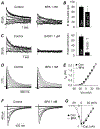Acute exposure to low-dose bisphenol A delays cardiac repolarization in female canine heart - Implication for proarrhythmic toxicity in large animals
- PMID: 36584932
- PMCID: PMC9852101
- DOI: 10.1016/j.fct.2022.113589
Acute exposure to low-dose bisphenol A delays cardiac repolarization in female canine heart - Implication for proarrhythmic toxicity in large animals
Abstract
Bisphenol A (BPA) is a common environmental chemical with a range of potential adverse health effects. The impact of environmentally-relevant low dose of BPA on the electrical properties of the hearts of large animals (e.g., dog, human) is poorly defined. Perturbation of cardiac electrical properties is a key arrhythmogenic mechanism. In particular, delay of ventricular repolarization and prolongation of the QT interval of the electrocardiogram is a marker for the risk of malignant arrhythmias. We examined the acute effect of 10-9 M BPA on the electrical properties of female canine ventricular myocytes and tissues. BPA rapidly delayed action potential repolarization and prolonged action potential duration (APD). The dose response curve of BPA on APD was nonmonotonic. BPA rapidly inhibited the IKr K+ current and ICaL Ca2+ current. Computational modeling indicated that the effect of BPA on APD can be accounted for by its suppression of IKr. At the tissue level, BPA acutely prolonged the QT interval in 4 left ventricular wedges. ERβ signaling contributed to the acute effects of BPA on ventricular repolarization. Our results demonstrate that BPA has QT prolongation liability in female canine hearts. These findings have implication for the potential proarrhythmic cardiac toxicity of BPA in large animals.
Keywords: Arrhythmia marker; Bisphenol A; Canine heart; Low dose; QT prolongation; hERG channel.
Copyright © 2022 Elsevier Ltd. All rights reserved.
Conflict of interest statement
Declaration of competing interest The authors declare that they have no known competing financial interests or personal relationships that could have appeared to influence the work reported in this paper.
Figures





Comment in
-
Choice of experimental model determines translational impact: The link between bisphenol A and cardiotoxicity.Food Chem Toxicol. 2023 Apr;174:113667. doi: 10.1016/j.fct.2023.113667. Epub 2023 Feb 13. Food Chem Toxicol. 2023. PMID: 36791906 Free PMC article. No abstract available.
Similar articles
-
Proarrhythmic toxicity of low dose bisphenol A and its analogs in human iPSC-derived cardiomyocytes and human cardiac organoids through delay of cardiac repolarization.Chemosphere. 2023 Jul;328:138562. doi: 10.1016/j.chemosphere.2023.138562. Epub 2023 Mar 31. Chemosphere. 2023. PMID: 37004823 Free PMC article.
-
Cellular mechanism of the nonmonotonic dose response of bisphenol A in rat cardiac myocytes.Environ Health Perspect. 2014 Jun;122(6):601-8. doi: 10.1289/ehp.1307491. Epub 2014 Feb 25. Environ Health Perspect. 2014. PMID: 24569941 Free PMC article.
-
Molecular mechanisms underlying the rapid arrhythmogenic action of bisphenol A in female rat hearts.Endocrinology. 2013 Dec;154(12):4607-17. doi: 10.1210/en.2013-1737. Epub 2013 Oct 18. Endocrinology. 2013. PMID: 24140712 Free PMC article.
-
Cardiac voltage-gated ion channels in safety pharmacology: Review of the landscape leading to the CiPA initiative.J Pharmacol Toxicol Methods. 2017 Sep;87:11-23. doi: 10.1016/j.vascn.2017.04.002. Epub 2017 Apr 11. J Pharmacol Toxicol Methods. 2017. PMID: 28408211 Review.
-
Enhanced repolarization capacity: new potential antiarrhythmic strategy based on HERG channel activation.Curr Med Chem. 2011;18(24):3607-21. doi: 10.2174/092986711796642382. Curr Med Chem. 2011. PMID: 21774764 Review.
Cited by
-
Comparative cardiotoxicity assessment of bisphenol chemicals and estradiol using human induced pluripotent stem cell-derived cardiomyocytes.Toxicol Sci. 2024 Mar 26;198(2):273-287. doi: 10.1093/toxsci/kfae015. Toxicol Sci. 2024. PMID: 38310357 Free PMC article.
-
Choice of experimental model determines translational impact: The link between bisphenol A and cardiotoxicity.Food Chem Toxicol. 2023 Apr;174:113667. doi: 10.1016/j.fct.2023.113667. Epub 2023 Feb 13. Food Chem Toxicol. 2023. PMID: 36791906 Free PMC article. No abstract available.
-
Association of same-day urinary phenol levels and cardiac electrical alterations: analysis of the Fernald Community Cohort.Environ Health. 2024 Sep 19;23(1):76. doi: 10.1186/s12940-024-01114-x. Environ Health. 2024. PMID: 39300535 Free PMC article.
-
Association of same-day urinary phenol levels and cardiac electrical alterations: analysis of the Fernald Community Cohort.Res Sq [Preprint]. 2024 May 31:rs.3.rs-4445657. doi: 10.21203/rs.3.rs-4445657/v1. Res Sq. 2024. Update in: Environ Health. 2024 Sep 19;23(1):76. doi: 10.1186/s12940-024-01114-x. PMID: 38853936 Free PMC article. Updated. Preprint.
References
-
- Abi-Gerges N, Philp K, Pollard C, Wakefield I, Hammond TG, Valentin JP, 2004. Sex differences in ventricular repolarization: from cardiac electrophysiology to Torsades de Pointes. Fundam Clin Pharmacol 18, 139–151. - PubMed
-
- Arias-Loza PA, Jazbutyte V, Pelzer T, 2008. Genetic and pharmacologic strategies to determine the function of estrogen receptor alpha and estrogen receptor beta in cardiovascular system. Gend Med 5 Suppl A, S34–45. - PubMed
MeSH terms
Substances
Grants and funding
LinkOut - more resources
Full Text Sources
Medical
Miscellaneous

